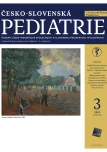Partial breastfeeding at discharge does not predict insufficient breastfeeding in the first six months
Authors:
Křížová Marcela 1; Kollárová Jana 1; Straňák Zbyněk 1,2
Authors‘ workplace:
Ústav pro péči o matku a dítě, Praha
1; 3. lékařská fakulta Univerzity Karlovy, Praha
2
Published in:
Čes-slov Pediat 2023; 78 (3): 172-175.
Category:
Original Papers
doi:
https://doi.org/10.55095/CSPediatrie2023/023
Overview
Exclusive breastfeeding is confirmed to be the optimal form of nutrition for children up to six months of age. Exclusive breastfeeding at discharge from the hospital is considered a prerequisite for successful and long-lasting breastfeeding. However, many newborns are discharged on only partial breastfeeding or artificial formula. The aim of this study was to analyse the type of nutrition at age 3 months and 6 months in babies who were not exclusively breastfed at discharge from delivery hospital.
In a prospective observational study, total number of 72 healthy term newborn were analysed, of them, 63 were partially breastfed at discharge and 9 of them had artificial formula only. Exclusive breastfeeding was documented in 20 infants (32%) at 3 months and in 12 (19%) at 6 months. Exclusive breastfeeding was more prevalent in children of primiparous compared to multiparous mothers (31% vs 18%, p=0.025). No significant differences were found according to mode of delivery, indications for operative delivery (elective vs. acute) and postnatal adaptation.
The study revealed that even following early partial breastfeeding, there is a certain probability of switching to exclusive breastfeeding during the first six months of life.
Keywords:
newborn – partial breastfeeding – exclusive breastfeeding – HMO formula
Sources
1. Fewtrell M, Bronsky J, Campoy C, et al. Complementary feeding: A Position Paper by the European Society for Paediatric Gastroenterology, Hepatology, and Nutrition (ESPGHAN) Committee on Nutrition. J Pediatr Gastroenterol Nutr 2017; 64(1): 119–132.
2. Qiao J, Dai LJ, Zhang Q, Ouyang YQ. A meta-analysis of the association between breastfeeding and early childhood obesity. J Pediatr Nurs 2020; 53: 57–66.
3. Victora CG, Bahl R, Barros AJ, et al. Breastfeeding in the 21st century: epidemiology, mechanisms, and lifelong effect. Lancet 2016; 387(10017): 475–90.
4. Dokoupilová M. Projekt „zmapování kojení v ČR“. https://www.neonatologie. cz/sekce.
5. Bělohlávková S, Bronský J, Burianová I, et al. Doporučení Pracovní skupiny dětské gastroenterologie a výživy ČPS pro výživu kojenců a batolat. Ces-slov Pediat 2014; 69 (Suppl. 1): 3–6.
6. Depoorter L, Vandenplas Y. Probiotics in pediatrics. A review and practical guide. Nutrients 2021; 13(7): 2176.
7. Patel S, Patel S. The effectiveness of lactation consultants and lactation counselors on breastfeeding outcomes. J Hum Lact 2016; 32(3): 530–41.
8. Moore ER, Bergman N, Anderson GC, et al. Early skin-to-skin contact for mothers and their healthy newborn infants. Cochrane Database Syst Rev 2016; 11(11): CD003519.
9. Balogun OO, O’Sullivan EJ, McFadden A, et al. Interventions for promoting the initiation of breastfeeding. Cochrane Database Syst Rev 2016; 11(11): CD001688.
10. Bakoula Ch, Nicolaido P, Veltsista A, et al. Does exclusive breastfeeding increase after hospital discharge? A Greek study. J Hum Lact 2007 ;23(2): 165–173/quiz 174–178.
Labels
Neonatology Paediatrics General practitioner for children and adolescentsArticle was published in
Czech-Slovak Pediatrics

2023 Issue 3
Most read in this issue
- Inherited disorders of carbohydrate metabolism
- Sclerosing cholangitis in children with inflammatory bowel disease
- Late diagnosis of mucopolysaccharidosis type I in a girl with hand contractures
- Hepatocellular carcinoma in an infant with tyrosinemia type 1
